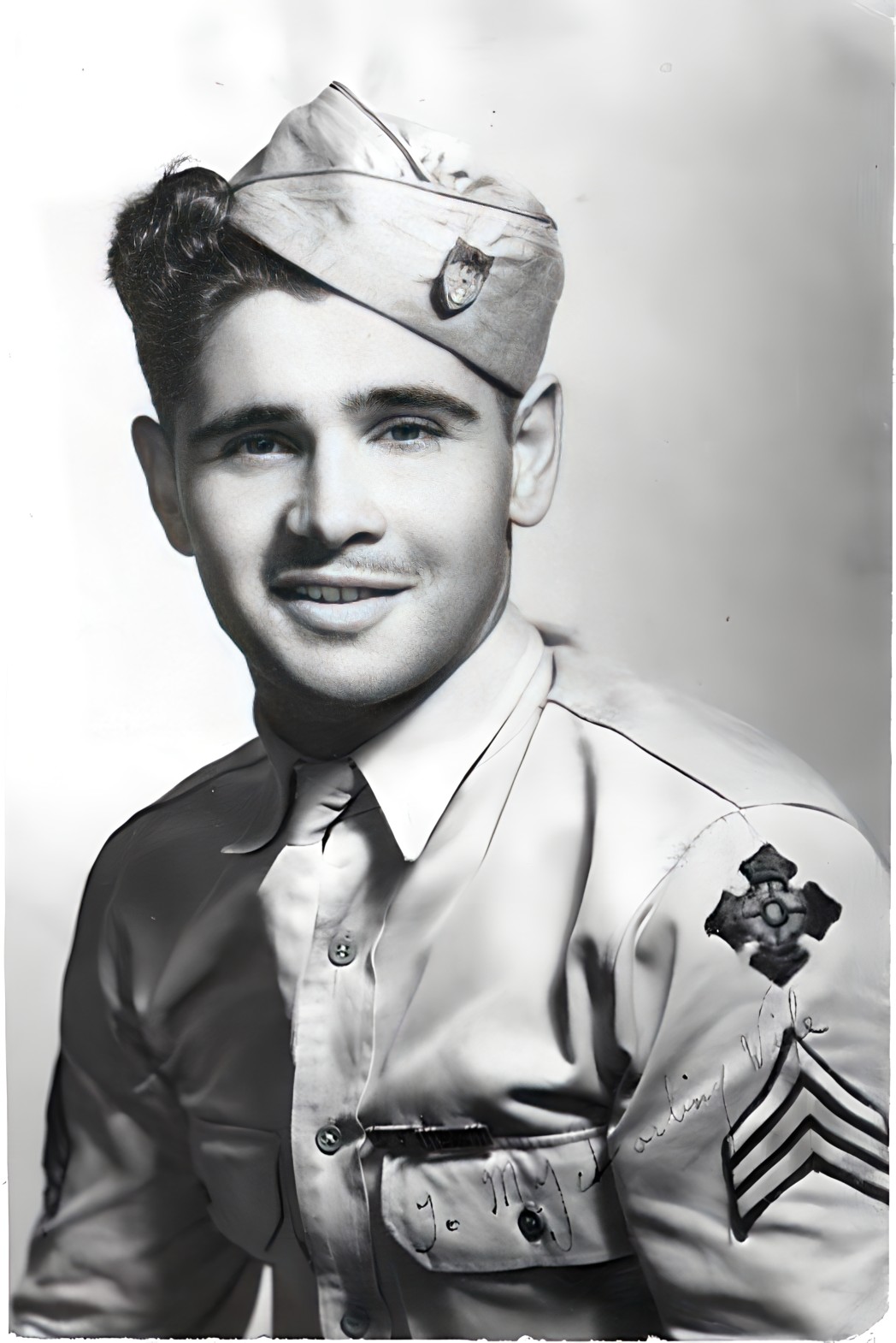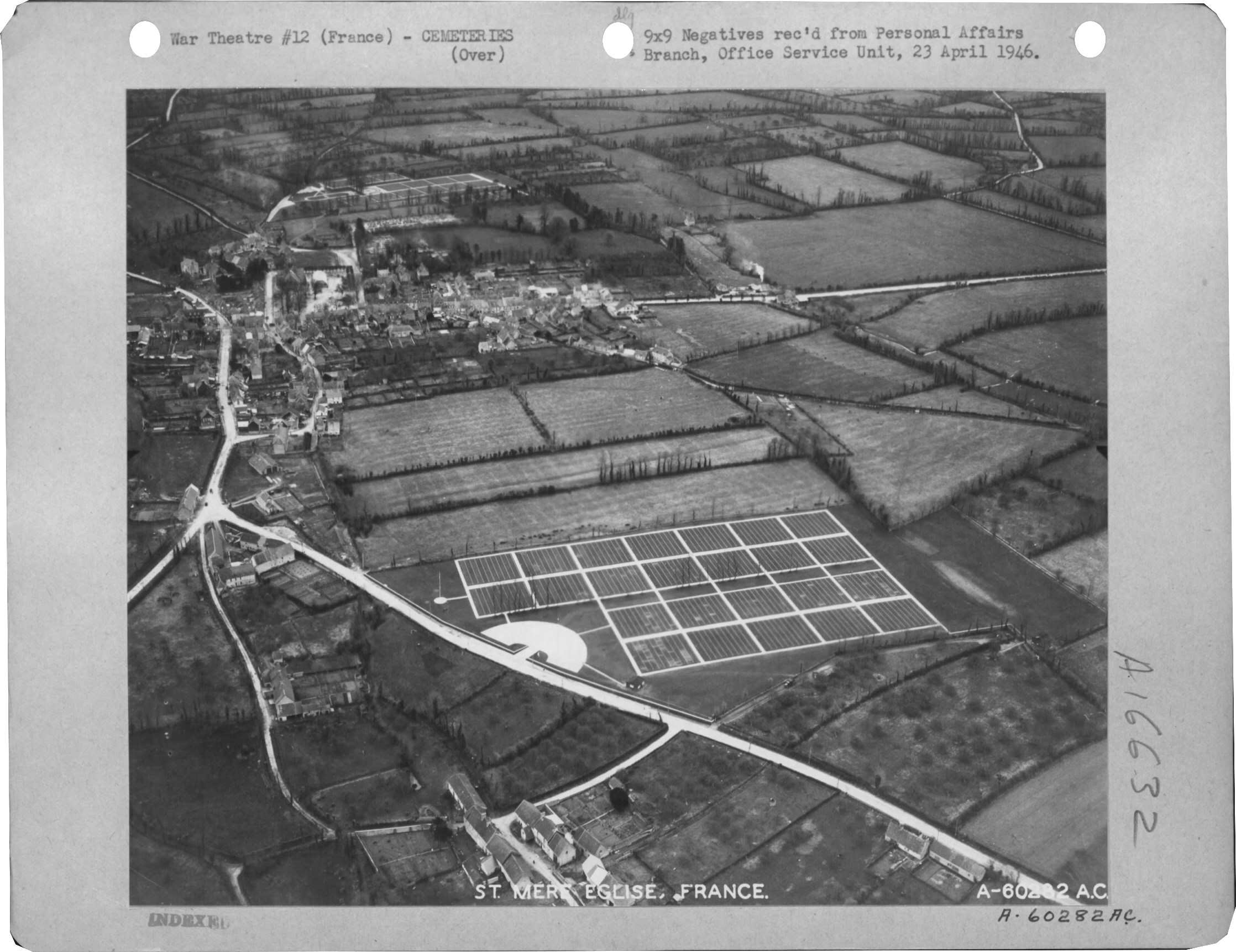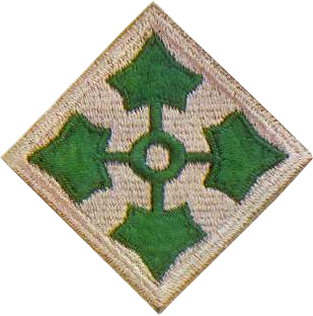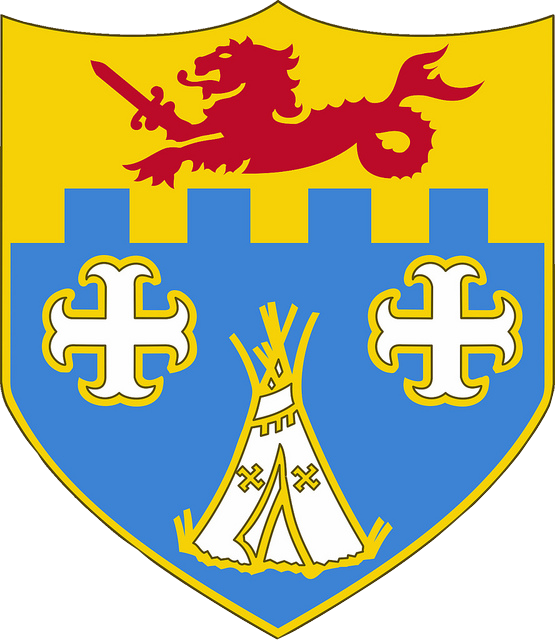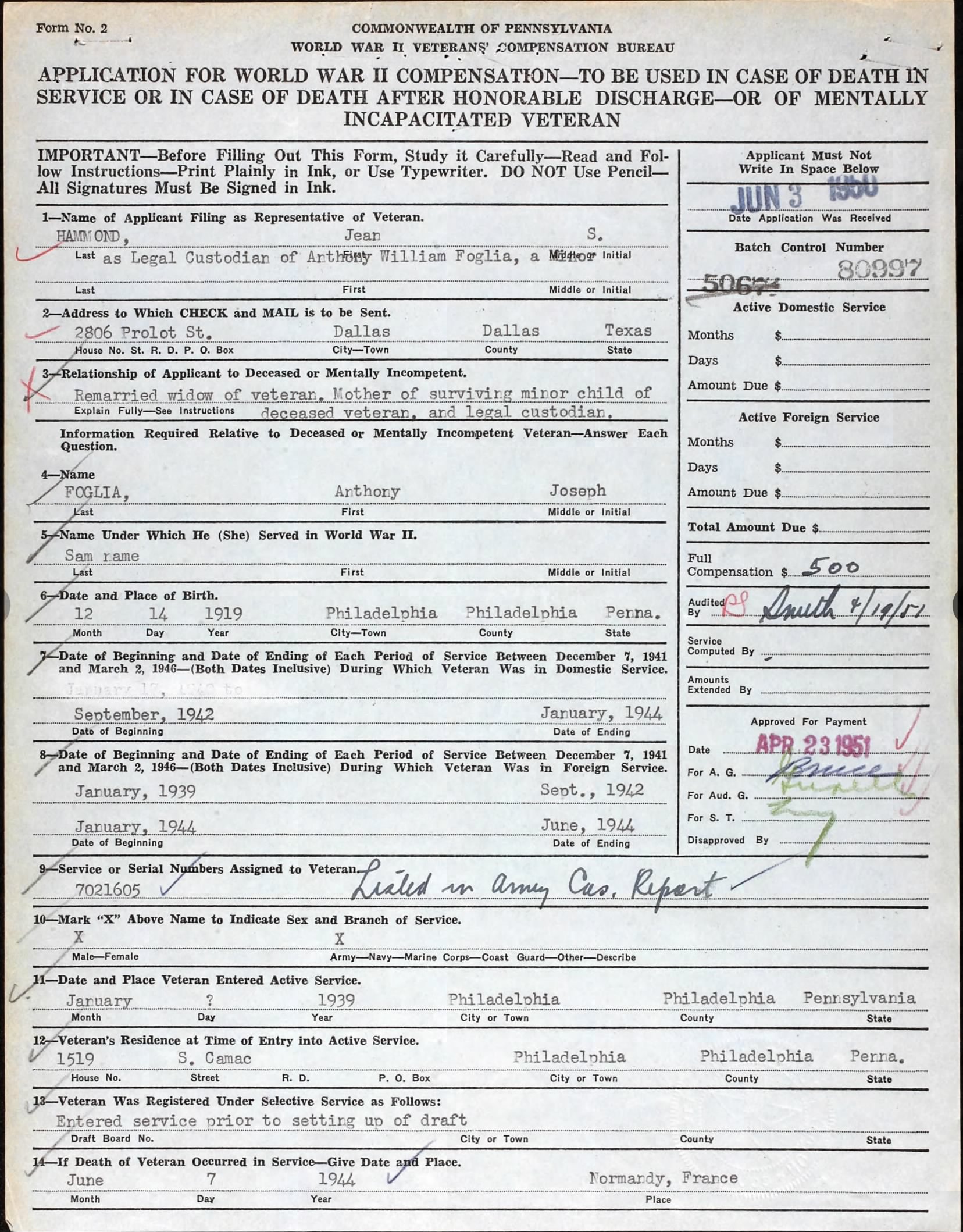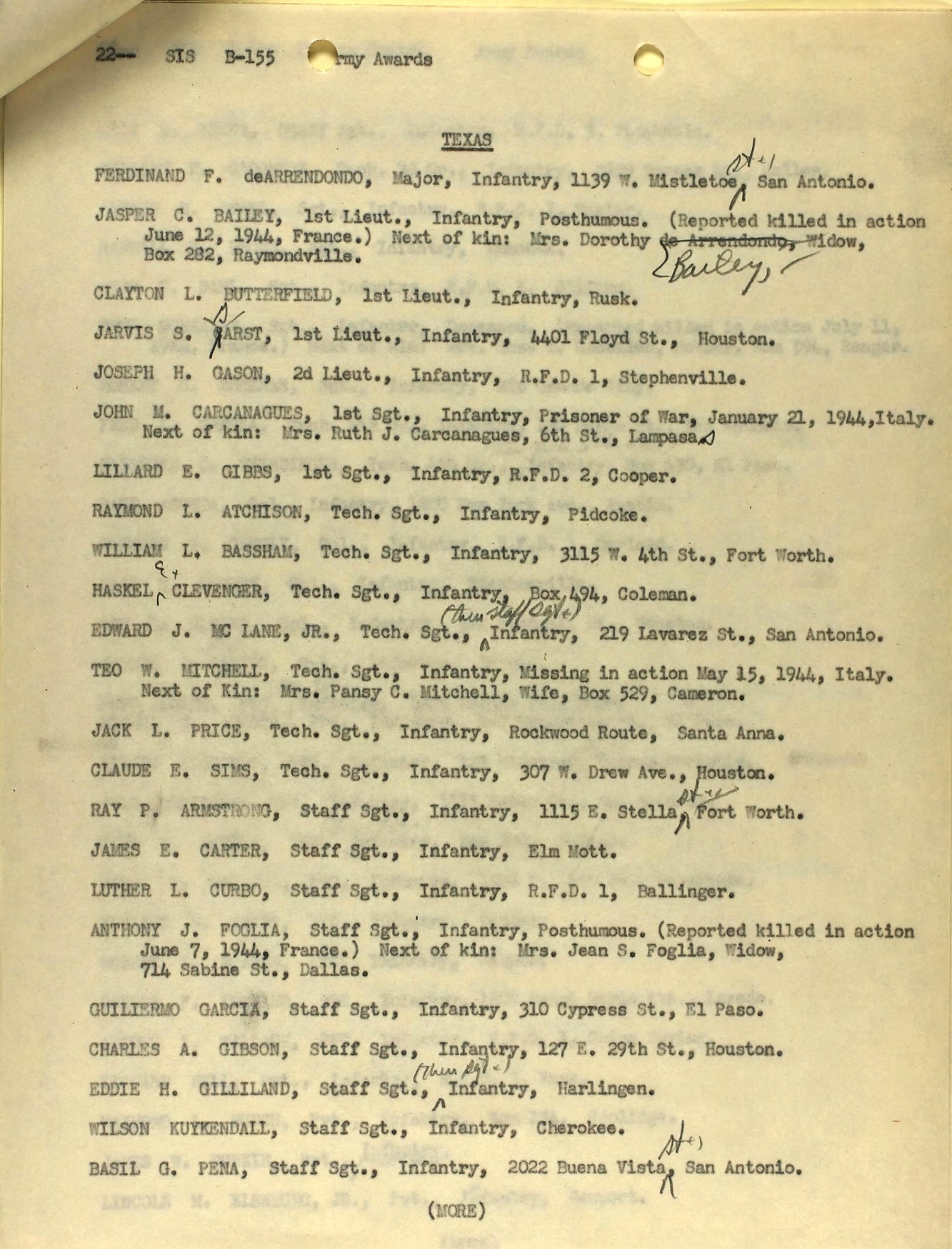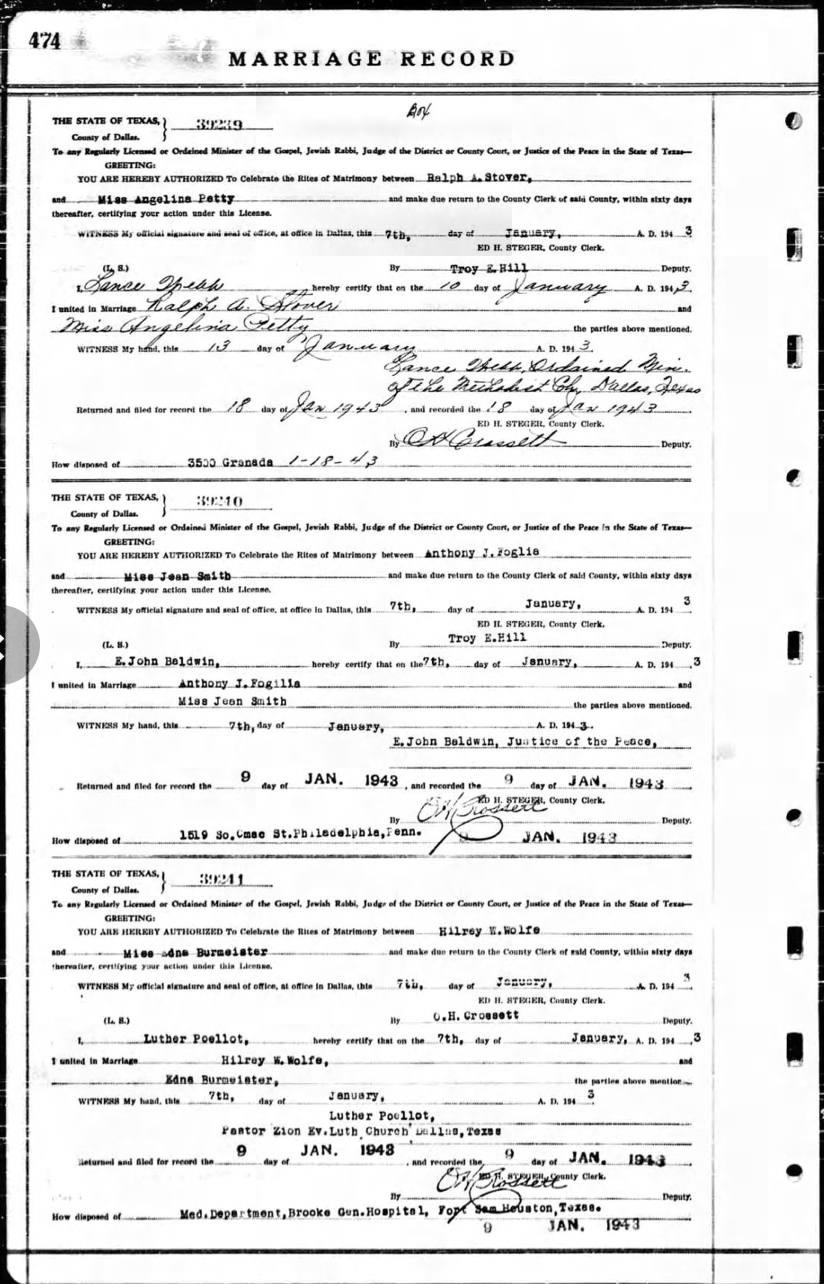|
Anthony Joseph FOGLIA
| ||||||||||||||||||||||||
|---|---|---|---|---|---|---|---|---|---|---|---|---|---|---|---|---|---|---|---|---|---|---|---|---|
|
Source : Phyllis Shadden (Ellen Marchese)
| ||||||||||||||||||||||||
| NUMBER OF SERVICE | 7021605 | |||||||||||||||||||||||
| AGE | 24 yo | |||||||||||||||||||||||
| DATE OF BIRTH | 14 December 1919 Philadelphia, Philadelphia County, PENNSYLVANIA | |||||||||||||||||||||||
| ENLISTMENT STATE | PENNSYLVANIA | |||||||||||||||||||||||
| FAMILY | Parents : William & Concetta FOGLIA | |||||||||||||||||||||||
| RANK | Staff Sergeant | |||||||||||||||||||||||
| FONCTION | Infantry Man | |||||||||||||||||||||||
| JOB BEFORE ENLISTEMENT | Unskilled occupations in manufacture of miscellaneous electrical equipment |  | ||||||||||||||||||||||
| DATE of ENLISTEMENT | 17 January 1940 | |||||||||||||||||||||||
| COMPANY | Company | |||||||||||||||||||||||
| REGIMENT | 12th Infantry Regiment | |||||||||||||||||||||||
| DIVISION | 4th Infantry Division | |||||||||||||||||||||||
| DATE OF DEATH | 7 June 1944 |
Source : Frogman | ||||||||||||||||||||||
| STATUS | KIA | |||||||||||||||||||||||
| PLACE OF DEATH | Sector of Ste Mère Eglise | |||||||||||||||||||||||
| CEMETERY TEMPORARY |
CEMETERY TEMPORARY of Sainte Mère Eglise #2 N°3586
| |||||||||||||||||||||||
| CEMETERY | NORMANDY AMERICAN CEMETERY of Colleville | |||||||||||||||||||||||
| GRAVE |
| |||||||||||||||||||||||
| DECORATION |
| |||||||||||||||||||||||
| ||||||||||||||||||||||||
| STORY | ||||||||||||||||||||||||
|
Source : Source : Fold 3 |
By : smithada_1 Anthony Joseph Foglia was born on 14 Dec 1919 in Philadelphia, PA and died on 7 Jun 1944 in Normandy, France as the result of hostile action on D-Day+1 in WWII. His parents were William Foglia (1892-1958) and Mary Conchetta Petro (1896-1969). Both of his parents were born in Italy. Per the 1920 and 1930 US Census, his father worked as a carpenter in a factory and his mother was a housewife. In the 1940 census, Anthony was a member of Company K, 19th Infantry stationed in Wahiaua, HI. Anthony had 1 older and 1 younger sister. Edward completed 2 years of high school and it seems he was unemployed prior to entering the Army. Edward married Jean Naspa Smith (1926-2015) on 7 Jan 1943. They had a son named Anthony William Foglia (1944-2011). No more information was available on their son. Jean remarried a Mr. Hammond and they lived in Dallas, TX. | |||||||||||||||||||||||
|
Anthony initially served in the Army, prior to the military draft, from Jan 1939 to Sep 1942. As mentioned above, he spent part of his time in the Army stationed in Hawaii. He later enlisted in the Army on 12 Jan 1942 at Ft. Meade, MD as a private in the infantry. His service number was 7021605. There is obviously a discrepancy in these dates which could not be resolved. It is not known where he attended any of his initial military training. He was eventually assigned to the 12th Infantry Regiment, 4th Infantry Division. Unfortunately, his company assignment is not known which makes it difficult to describe what happened to him on 7 Jun 1944. The 12th Infantry Regiment was reorganized as a motorized infantry regiment on 29 Sep 1942. On 1 Aug 1943, it was again reorganized as a standard infantry regiment in the 4th Infantry Division. The division participated in battlefield maneuvers in Florida starting in Sep 1943 and then moved to Camp Jackson, SC on 1 Dec 1943 where they were alerted for overseas movement and moved to Camp Kilmer, NJ. On 18 Jan 1944, the division departed New York arriving in England on 26 Jan 1944. The division then continued to train for the Normandy invasion until the end of May 1944. The mission of the 4th ID was to secure a beachhead on the Cotentin Peninsula, the location of the important port facilities at Cherbourg. The 12th Regiment saw its first action in WWI when it spearheaded the assault landing on Utah Beach. The Division departed ports in England on 5 Jun 1944 on 4 troop transports and travelled to rendezvous points about 12 miles off the coast of Normandy. About 5000 soldiers boarded their Landing Craft, Vehicle, Personnel (LCVP) for the 3 hour trip to Utah Beach. The seas were rough and the weather bad which caused many soldiers to become seasick while at the same time getting drenched. The assault was to be in 4 waves and the first soldiers hit the beaches at about 0630 6 Jun 1944 and they secured Utah Beach in short order with very few casualties. The landing for the soldiers was physically demanding as they had to wade through about 200 yards of surf, sometimes neck deep, weighed down with about 70 pounds of equipment. Once they reached the beach, they had to cross about 550 yards of open beach while being fired on by the Germans. The 4th ID landed 21,000 troops on Utah beach at the cost of only 197 casualties. After successfully securing Utah Beach, the 4th ID's next mission was to link up with the 82d Airborne Division which had landed behind Utah Beach early in the morning of 6 Jun 1944. SSgt Foglia survived the landing but was later killed on 7 Jun as the regiment moved inland to link up with the 82d Airborne Division near Saint Mer Eglise, France. The exact circumstances surrounding his death are not known. | ||||||||||||||||||||||||
|
Source : Fold 3 |
SSgt Foglia’s remains were initially buried at Cemetery #3586 (block V, row 1, grave 11), Saint Mere Eglise #2, Carentan, France. His remains were eventually buried at the Normandy American Cemetery (plot C, row 27, grave 20) at Collsville-sur-mer, France. SSgt Foglia was awarded the Bronze Star and Purple Heart. |
Source : Fold 3 | ||||||||||||||||||||||
|
Source : Fold 3 | ||||||||||||||||||||||||
Activated/Activé |
Normandy/Normandie |
| 1 Jun 1940 | Days of Combat/Jour de Combat 299 |
| Casualties/Victimes 22 660 | |
Entered Combat/Entré au combat |
|
| 6 Jun 44 D-Day | |
|
Commanding Generals/Commandants généraux Maj. Gen. Walter E. Prosser (Jun 40 - Oct 40) |
Campaigns/CampagnesNormandy (6 Jun 44 - 24 Jul 44)
|
PLAN DE ROUTE DE LA CAMPAGNE - CAMPAIGN ROUTE MAP |
|
 |
|
DIVISION CHRONICLEThe 8th Infantry Regiment of the 4th Division was one of the first Allied units to hit the beaches at Normandy on D-day, 6 June 1944. Relieving the isolated 82nd Airborne Division at Ste. Mere Eglise, the 4th cleared the Cotentin peninsula and took part in the capture of Cherbourg, 25 June. After taking part in the fighting near Periers, 6-12 July,, the Division broke through the left flank of the German Seventh Army, helped stem the German drive toward Avranches, and by the end of August had moved to Paris, assisting the French in the liberation of their capital. The 4th then moved into Belgium through Houffalize to attack the Siegfried Line at Schnee Eifel, 14 September, and made several penetrations. Slow progress into Germany continued in October, and by 6 November the Division reached the Hurtgen Forest, where a severe engagement took place until early December. It then shifted to Luxembourg, only to meet the German winter offensive head-on, 16 December 1944. Although its lines were dented, it managed to hold the Germans at Dickweiler and Osweiler, and, counterattacking in January across the Sauer, overran German positions in Fouhren and Vianden. Halted at the Prum in February by heavy enemy resistance, the Division finally crossed 28 February near Olzheim, and raced on across the Kyll, 7 March. After a short rest, the 4th moved across the Rhine 29 March at Worms, attacked and secured Wurzburg and by 3 April had established a bridgehead across the Main at Ochsenfurt. Speeding southeast across Bavaria, the Division had reached Miesbach on the Isar, 2 May 1945, when it was relieved and placed on occupation duty. |
CHRONIQUE DE DIVISIONLe 8e régiment d'infanterie de la 4e division fut l'une des premières unités alliées à débarquer sur les plages de Normandie le 6 juin 1944, jour du débarquement. Soulager la 82nd Airborne Division isolée de Ste. Mère Eglise, le 4e défricha la presqu'île du Cotentin et participa à la prise de Cherbourg le 25 juin. Après avoir pris part aux combats près de Periers, du 6 au 12 juillet, la Division a franchi le flanc gauche de la Septième armée allemande, aidé à endiguer la route allemande vers Avranches et, à la fin du mois d'août, s'est installée à Paris, aidant les Français. dans la libération de leur capitale. Le 4e s'est ensuite déplacé en Belgique par Houffalize pour attaquer la ligne Siegfried à Schnee Eifel, le 14 septembre, et a fait plusieurs pénétrations. Les progrès lents en Allemagne se sont poursuivis en octobre et, le 6 novembre, la division a atteint la forêt de Hurtgen, où un engagement sévère a eu lieu jusqu'au début du mois de décembre. Il s'est ensuite déplacé vers le Luxembourg, seulement pour affronter l'offensive allemande d'hiver, le 16 décembre 1944. Bien que ses lignes aient été bosselées, il a réussi à tenir les Allemands à Dickweiler et Osweiler et, contre-attaquant en janvier à travers la Sauer à Fouhren et Vianden. Arrêtée au Prum en février par une forte résistance ennemie, la Division a finalement franchi le 28 février près d'Olzheim et a couru à travers le Kyll, le 7 mars. Après un court repos, le 4 mars traversa le Rhin à Worms, attaqua et sécurisa Wurzburg le 29 mars et, le 3 avril, il établit une tête de pont sur le Main à Ochsenfurt. Accélérant le sud-est à travers la Bavière, la division avait atteint Miesbach sur l'Isar, le 2 mai 1945, quand elle fut relevée et placée en devoir d'occupation. |
| SOURCE INFORMATION & PHOTO | Armydivs.squarespace.com |
|---|
| SOURCE INFORMATION & SOURCE PHOTO | Anthony Maëlya Mauclair - Aad.archives.gov - Abmc.gov - Findagrave.com - Fold3.com |
|---|---|
| PROGRAMMER | Henri, Garrett, Clive, Frédéric & Renaud |




















